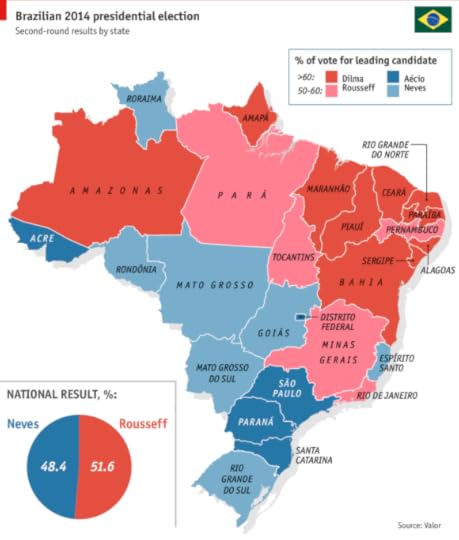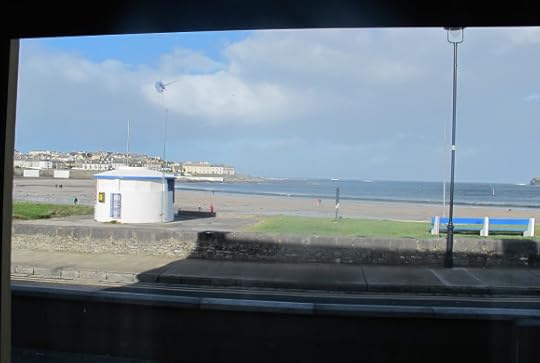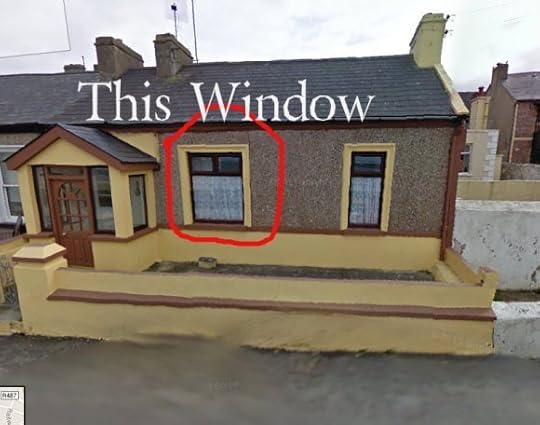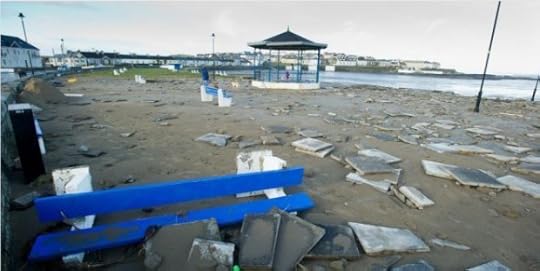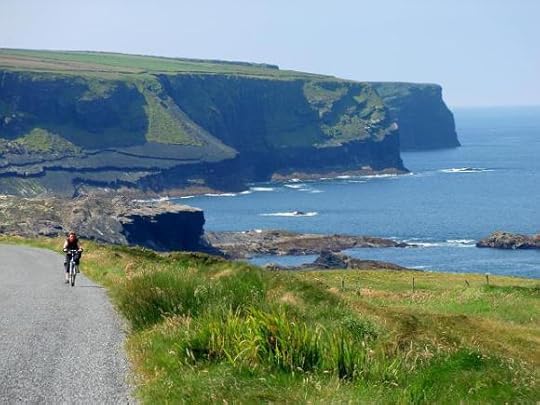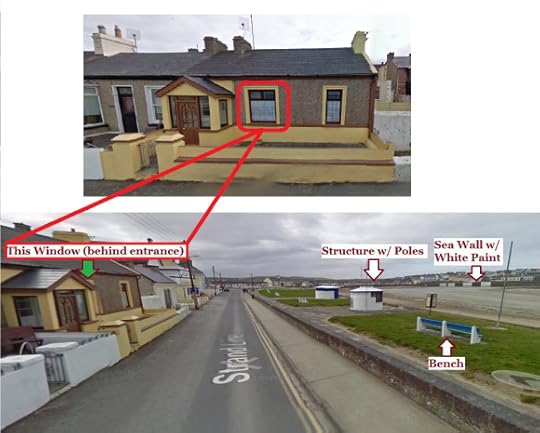Andrew Sullivan's Blog, page 110
October 28, 2014
Quarantanamo, New Jersey, Ctd
Chris Christie went on TV this morning to defend his mandatory quarantine policy for health workers returning from Ebola-afflicted countries:
“I don’t think it’s draconian,” Christie, appearing on the Today show, said of New Jersey’s mandatory 21-day quarantine on health care workers returning from Liberia, Sierra Leone, or Guinea. “The members of the American public believe it is common sense, and we are not moving an inch. Our policy hasn’t changed and our policy will not change.” … The governor also said the CDC has been too slow to change its policies, and is now “incrementally taking steps to the policy we put in effect in New Jersey.” The CDC announced on Monday new guidelines for people traveling from West Africa, but still recommends voluntary at-home isolation rather than state-mandated quarantines.
Ben Wallace-Wells thinks “that Christie, and also [New York Governor] Cuomo, simply misread the nature of the public alarm”:
Despite the tone on cable news, and despite the wildly over-publicized decisions of a few parents in a few school districts to keep their kids home, there hasn’t been a public panic over Ebola. People are still traveling on airplanes. They are not flooding the hospitals with anxieties that minor symptoms might portend Ebola. Everyone whose job it is to predict public opinion seems to have been bracing for a panic. But it hasn’t come.
A dumb and snotty cottage industry has developed in making fun of those who are freaking out. (As I write, the most-viewed story on The New Yorker‘s website is a “humor” column by Andy Borowitz titled, “Study: Fear of Ebola Highest Among People Who Did Not Pay Attention During Math and Science Classes.”) But really there hasn’t been much excess fear at all.
Earlier Dish on that media coverage here. In Alex Altman’s view, Christie tried to score some political points from the crisis, but his plan backfired:
For Christie, the panic wrought by the lethal virus may have seemed a prime opportunity to run his favorite play: the one where the tough leader takes a common-sense stand in the face of federal dithering. This is the move that drew bipartisan plaudits after Hurricane Sandy ravaged the Jersey shore in 2012, and one Christie may hope will propel a possible presidential candidacy in 2016. The play has worked swimmingly when run against teachers’ unions, or bungling bureaucrats, or “idiots” loitering on a stretch of beach in the face of an oncoming storm. It doesn’t wear as well when the target is a nurse who risked her life to fight a deadly disease.
The Bloomberg View editors chastise the governors:
Clearly, their decision was unnecessary and premature. Yet it also displays a worrisome disconnect in national public-health networks. Some amount of public panic is to be expected, and must be addressed. State health officials, however, should know better — both about how Ebola spreads and the dangers of mandatory quarantines. … During the SARS epidemic of 2003, public health officials learned that voluntary quarantines — simply requesting that people who might have infectious illness limit their social interactions for a period of time — are as effective as forced quarantines in helping stem an outbreak.
But Noah Rothman defends Christie from the flak he’s taking from both left and right:
Chris Christie did not deserve the left’s self-satisfied recriminations when he instituted stricter measures aimed at curtailing the spread of Ebola in America, programs which enjoy broad support, and he does not merit the scorn heaped upon him by the right for refusing to indefinitely intern a person who likely does not carry the disease. The right is deeply mistrustful of Chris Christie and, on some level, he has earned their suspicion. In this case, it is clear that apprehension among the right toward Christie is verging on compulsive and insidious. Liberals did not enjoy a victory when [Kaci] Hickox was transferred out of containment, but, by insisting Christie somehow endorsed the White House’s position, the right is busily handing them one.









Has The CDC Been Too Blasé?
Yesterday, the Centers for Disease Control and Prevention issued new guidelines for people at risk of coming down with Ebola, meaning primarily health workers returning from West Africa:
On Monday, the CDC broke down people in the orbit of Ebola into four categories. Those at highest risk are anyone who’s had direct contact with an Ebola patient’s body fluids, including health care workers who suffer a needle-stick injury during a patient’s care. For those people who are at highest risk and asymptomatic, the CDC recommended restrictions on commercial travel or attendance at public gatherings. The guidelines were not specific about where a person should stay, but officials said they meant home or hospital isolation. For those with some risk, like who lived in a household with an Ebola patient but didn’t have direct contact, travel restriction can be decided on a case-by-case basis, government officials said.
But states are not bound by these guidelines and are free to implement their own protocols, as several more states have done following New York and New Jersey’s lead:
Virginia Gov. Terry McAuliffe (D) and Maryland Gov. Martin O’Malley (D) held separate news conferences Monday announcing their plans for Ebola containment. Travelers from Guinea, Liberia and Sierra Leone will be assessed by health workers and asked to agree to a 21-day monitoring protocol. Higher-risk travelers will be visited at home by health workers and asked to stay there. Individuals refusing to sign the protocol agreement or not following the rules could be involuntarily quarantined, officials said.
Georgia Gov. Nathan Deal (R) on Monday announced a more aggressive Ebola-containment policy. Travelers from West Africa who don’t show symptoms, but who are considered high risk because of “known direct exposure” to Ebola patients, will be subject to quarantine at a designated facility, Deal’s office said.
With military personnel helping fight the epidemic in Africa, the Pentagon is also taking a more cautious tack than the CDC:
Army spokesman Col. Steve Warren did not call the move a quarantine in a statement issued on Monday. Rather, he said that “about a dozen” troops were being monitored. “Out of an abundance of caution, the Army did direct a small number of military personnel (about a dozen) that recently returned to Italy to be monitored in a separate location at their home station (Vicenza),” Warren stated. “There has been no decision to implement this force wide and any such decision would be made by the secretary of Defense. None of these individuals have shown any symptoms of exposure.”
According to reports, the soldiers are being monitored away from their families for 21 days. The Army refuses to call the isolation a quarantine, although separating people for medical reasons meets the Centers for Disease Control and Prevention’s definition of quarantine.
Allahpundit ridicules the CDC’s recommendations, which in his opinion are “one notch more casual than [they] should be”:
To this day, if I’m not mistaken, Kent Brantly and Nancy Writebol don’t know how they contracted the disease in Africa; Doctors Without Borders, which naturally follows strict protocols in treating patients, has nonetheless seen 16 staffers come down with it, nine of whom died. Presumably Spencer had no reason to think he’d contracted it or he wouldn’t have gone bowling. If even trained professionals are getting caught by surprise in their exposure, why would the CDC err on the side of less quarantine once they’re back home? The public’s confidence in the agency is going to get much, much worse, needless to say, if we end up with another transmission from the “low” or “some risk” category.
The irony of all this, as Tim Cavanaugh notes, is that it’s the doctors at the centers of it who are making the public more, not less, anxious (not “panicked,” as is often wrongly said). If Spencer and Snyderman had diligently quarantined themselves, the public would have greater faith that voluntary quarantines are an acceptable alternative to the sort of state-imposed measure that Christie’s getting hammered for today.
And Jazz Shaw insists that protocols that rely on voluntary quarantines and self-reporting simply aren’t good enough:
People facing a potentially dire situation will frequently be in denial. We see that all the time with folks who avoid going to the doctor only to find out later that all of those warning signs were, indeed, cancer. But if you can’t bring yourself to admit it in your own mind, you likely won’t be checking off those boxes on a form either. Further, you might be thinking that it can’t possibly be Ebola, so why would I go through all the hassle of reporting this? Where would they get that idea? Maybe from hearing an endless stream of government spokesmodels being paraded across your television screen telling you that it’s almost impossible to catch in the first place. And if you’ve had that drilled into your head often enough, who wants to go get locked up in their house for three weeks for what is almost certainly just a case of the flu?
Follow all of our Ebola coverage here, compiled primarily by Jonah Shepp, the irrepressible young Dish editor.









Yglesias Award Nominee
“Argument is like all other human behaviors: subject to conditioning through reward and punishment. And we’ve created these incentives on the left: always politicize; always escalate; always ridicule. We’re living with the consequences of those tendencies now. Unfortunately, I don’t know how we build a new left discourse, given that the two current modes of left-wing expression appear to be a) showily condescending ridicule and b) utter fury.
I mean you can guess what the response by some will be to this essay: deBoer doesn’t think racism is real, he doesn’t think sexism is real, he wants people to just get over it when they’re the victims of sexism and racism. None of that is true. I write about the structural racism of our society constantly. I believe that we’re still a deeply, inherently sexist culture. (For example, you may have heard of #GamerGate.) And I absolutely believe that there are tons of daily encounters that demonstrate these problems, and that the victims of them should feel comfortable speaking out.
I just also think that we have to be able to say “you know, I don’t think that your particular political critique here is correct” without being accused of failing to oppose racism and sexism in general,” – Freddie DeBoer.
(Illustration: a visualization of the Twitterverse on Gamergate over 72 hours via Andy Baio, with the help of Gilad Lotan, chief data scientist at Betaworks. Look at the polarization. The data also found many many more misogynist tweets than those about ethics in gamer journalism.)









Book Club: Does The Self Exist? Ctd
A reader flags the long podcast seen above:
I started reading Waking Up after watching Sam Harris on Joe Rogan’s podcast. In it, Harris recounts his case against free will and mentioned that he thought that the self was an illusion. I am sympathetic to that view and in a manner believe it to be true, so I purchased Waking Up primarily to read his case on the question of self.
I can’t say I really came away with the tools to feel I can prove this belief. Harris writes in the mode of a skeptic and does so well. But nowhere does the book move fully beyond skepticism to proactive persuasion. So you ultimately end up with firm evidence that common conceptions of self are false, but then the final leap seems to be that moments of awe and the truth are … just self-evident. Something that just is. But some people aren’t going to interpret these moments in that way. Certainly many Christians will associate with the idea of divine light in these moments, as you do. People of other backgrounds will see it in other ways.
Another is more critical:
I love both you and Sam. I really do. I’m with him on the dangers and damage wrought by religion. With you on most political issues. But on this question from Waking Up, regarding the nature of the so-called “selfless” state of mind human beings sometimes experience during meditation or prayer, I’m afraid you are both wrong.
Andrew, why do you both seek transcendence so badly? For what you feel, what we all feel in these oceanic moments, is neither an experience of being flooded by God’s love (your view) or a glimpse into the underlying “selflessness” of consciousness (Sam’s view).
It is simply one way – one particularly harmonious and happy way! – that our particular species of primate experiences neuronal/electrical activity in our brains. We may speculate that meditation, prayer and the like probably have the effect of quieting activity in the left hemisphere and facilitating a more direct experience of the intuitive, non-verbal right hemisphere … something like that …
Whatever it is, it is most certainly NOT anything transcendent, nor showing us a “truth” about the selfless nature of the universe. It is part of what our limited biology, fashioned by millions upon millions of years of adaptation, does.
Why is it so hard for you, and now Sam too, to accept your body and brain for what they are: your ONLY portal to experience, limited as they are, sometimes impulsive and directed, sometimes undifferentiated and peaceful, but always YOURS, beautiful and mortal and precious.
It is always self, and that is okay. Andrew, I say lovingly: go with the love you feel, and you can leave out the “God” part. To Sam I want to say: go with the love you feel, and you can leave out the incoherent idea of some “selflessness” uncannily experienced by the self.
155 years after On the Origin of Species and this is still hard for people to accept. But once you do it is clarifying, and liberating. It’s all natural, all animal – all the way down.
Another reader wonders:
One question I would ask Harris: why do we have a sense of self in the first place? Despite its evanescent nature, it likely evolved over time through natural selection because it provided an evolutionary advantage at some point. It may very well be true that it is no longer useful to thrive in the 21st century, but to dismiss it out of hand and call it an illusion, without placing it in a scientific context, is kind of misleading.
Another reminds me why I am so fortunate to be a part of this blog-community:
For many years now I have had the experience of no-self (it is not my philosophy, it is actually my experience). This experience is almost impossible to write about, but I will do my best.
To begin with, it is not the case that my self vanished one day. Rather, I stopped identifying with the self. I realized that the self is a just thought that I am aware of, but the self is not what I am. The self has continued to exist as a thought that is very useful for survival and I expect it to continue to exist until death.
So if I am not the self, then what am I? I honestly have no idea. For many years, I felt like I was nothing. This sounds terrible, but it was actually very liberating. I did not feel like a dead, cold nothing, I just felt like I was no thing in particular. Compared with identifying as a separate person that is perpetually fearful, lonely, and confused, being nothing is wonderful.
Several years ago, I experienced a shift. I started to feel more and more like I was everything. The first time the feeling came on very strongly, I was sitting in Newark airport staring out at the Queens skyline. I experienced a unity between what I am and everything I am aware of: the beautiful sunrise, the sad buildings, the bagel I was eating, all my thoughts and feelings, etc. I felt like there was no inside and outside to what I truly am (even though I was aware of a self as a thought). For the first time in my life, I truly understood what it meant to love everything unconditionally. This feeling has never really gone away since then, although it is often more in the background of my experience while the self is in the foreground.
Regarding the apparent conflict between Sam Harris’s writings and Catholicism, I see them as emphasizing different partial truths. Harris, in line with meditative traditions, emphasizes breaking identification with the self. This can alleviate suffering, but it overlooks the unity of everything and the possibility of universal love. Catholicism, and other devotional religions, emphasize allowing the self to be “overcome by divine love” as you aptly put it. But when Catholicism insists on the existence of an eternal soul, it makes God something separate that exists outside of a person.
My own experience is that there is no separate self, there is only God, but a God does not exist apart from me. This is what St. Teresa of Avila calls “spiritual marriage” in the seventh mansion, or what Meister Eckhart meant when he said “my eye and God’s eye are one eye, one seeing”.
Here are four other thoughts that seem important. First, I have no idea why this grace came to me. I am not a special person in any way. Second, I have no idea how common this realization is or if it is becoming more common. Third, it has not impaired my ability to live a normal life with a family and job. People often remark that I seem really calm, but otherwise I look like an ordinary guy. Fourth, I have no desire to evangelize about this. I am only writing about it now because I feel that your readers will benefit by hearing that freedom from self is possible.
Anyway, I don’t know if I did a very good job explaining myself, but this is the best I can manage. If you would like to push further on this, I would suggest interviewing an American teacher named Adyashanti. He speaks eloquently about these matters and his realization is very deep. And as always, I appreciate the chance to contribute to the Dish.
That reader also wrote an eloquent email about his experiences with ibogaine, a powerful psychedelic from West Africa. Follow the whole Book Club discussion here. And join in by emailing your thoughts to bookclub@andrewsullivan.com.









A Tale Of Two Brazils
Jan Piotrowski discusses the results of Sunday’s other big election, in which incumbent president Dilma Rousseff, head of the left-wing Workers’ Party (PT), narrowly won re-election over her center-right, pro-market competitor Aécio Neves:
The upshot is that the president will lead a riven country. She romped to victory across swathes of the poor north and north-east—helped by less fortunate Brazilians’ gratitude for the PT’s popular social programmes, but also her campaign’s baseless insistence that Mr Neves would do away with them. Most of the richer south, south-east and centre-west plumped convincingly for her market-friendly rival.
“Despite winning the presidency for the fourth time in a row,” Anthony Pereira writes, “this was not a particularly good election for the PT “:
The party lost 18 seats in the lower house of Congress (though it remains the largest party) and one seat in the Senate (where it is the second-largest bloc). Congress as a whole has become more conservative and more fragmented, its 22 parties swelling to 28. The PT did win five governorships, but only one of them, Neves’s state of Minas Gerais, is in the populous and wealthy south-east. That means the centrist PMDB, a party committed to almost nothing except supporting the government in exchange for patronage, will once again be Dilma’s most important – and most problematic – political partner. The PT’s base, meanwhile, is clearly no longer the solid coalition it once was.
Mac Margolis casts doubt on Dilma’s ability to reunite the country, or even her own government:
Magnanimity is the victor’s disclaimer, but not once in her 27-minute rambling victory lap did Rousseff mention Neves or acknowledge the vote that clove Brazil in two. Lula Inc. don’t do gracious. What their Workers’ Party does do is power, and this is where Rousseff’s victory could sour. It’s not just the widening of the congressional aisle she must reach across. The hazard lies in her own court. Rousseff sits astride a nine-party coalition, where the appetites for patronage and power are now sharper.
Dom Phillips highlights the large numbers of Brazilians who didn’t vote for her, or anybody:
Rousseff needs to address another serious problem: corruption. A total of 54 million people voted for her, but 51 million voted for her opponent. A staggering 30 million simply abstained, even though voting is obligatory in Brazil, while more than seven million voted for no party. This represents a very high rejection of the Workers’ Party, a very real contempt for its repeated sleaze scandals and a widespread distrust of politicians of all stripes.
Pointing to the country’s troubled economy, the Bloomberg View editors advise Dilma to get cracking on reform:
Brazil’s economy entered a recession last quarter, and inflation is running above its targeted range. A global slowdown has hit the prices of commodities that comprise almost half its exports. Its budget deficit is widening, its credit rating in peril. Its economy remains hampered by a Byzantine tax system and formidable thicket of labor regulations. Thanks in part to its poor business climate, Brazil garners less investment than any other member of the BRICS (18 percent of its gross domestic product versus 31 percent for India). Upon news of her re-election, Brazil’s markets and currency promptly tanked. So what can Rousseff do? Her promise to revamp her cabinet offers the opportunity both to bring the country together politically and move it forward economically.
But Juan Carlos Hidalgo doubts she will move in that direction:
Can Rousseff deliver reform? Doubtful. As Mary O’Grady points out today in the Wall Street Journal, “Ms. Rousseff ran as the anti-market, welfare-state candidate.” With an economy not even growing by 1% and a stubbornly high inflation rate, the question Brazilians are asking themselves is whether Rousseff will reform or instead double-down on interventionist policies. One area to pay particular attention to is freedom of the press. What we’ve seen in a number of other Latin American countries ruled by left-wing governments is that, as the economy sours and corruption scandals mushroom, the authorities push for more regulations on the media. Will Brazil follow this pattern? There are good reasons not to be optimistic about Brazil in the next four years.
Meanwhile, Daniel Altman suspects we haven’t seen the last of Aécio – nor of Luiz Inácio Lula da Silva, Dilma’s political godfather:
As I’ve written here before, parties with a stranglehold on their countries for many years tend to become complacent and even crooked. Rousseff’s Workers Party will complete 16 years in the Palácio do Planalto at the end of her second term. At that point, it’s conceivable and even likely that Lula would come back and run again at the age of 72. Rousseff will have to earn him that third term. For now, given her record, the odds of Neves running again and winning must be quite high. He’s only 54, and hey — it took Lula four attempts to win the country’s highest office.









The Flower Of The Arab Spring
Updated: 5.2M Tunisians head to the polls, with a new consitution and a sense of optimism http://t.co/jjUQek648D pic.twitter.com/HlJHK5EZQc
— AJE News (@AJENews) October 26, 2014
Big election news out of Tunisia, where the moderate Islamist party Ennahda has conceded Sunday’s vote to their secular rivals Nidaa Tounes:
Official results have yet to be announced, but Nidaa Tounes said it has won at least 83 seats in the 217-member assembly over about 65 seats secured by Ennahda. Senior Ennahda official Lotfi Zitoun congratulated Nidaa Tounes, but called for the inclusion of Ennahda in the new coalition, for the formation of a unity government. Nidaa Tounes was established to counter Ennahda, and is led by Beji Caid Essebsi, a former parliament speaker under ousted President Zine el-Abidine Ben Ali, and the party includes other former Ben Ali officials, as well as union leaders and independent and secular politicians.
Pre-election Dish coverage here. As we noted, the vote was the first full parliamentary election since the 2011 revolution, and the first held under a new constitution adopted in January. Lindsay Benstead and colleagues breathe a sigh of relief at how smoothly it went:
Sunday’s elections were enormously significant precisely because they were seemingly uneventful.
The turnout was unexpectedly high, reaching over 60 percent of registered voters. Voting was peaceful, and as strong turnout figures came in, Tunisians were exuberant. Perhaps most important, the elections saw peaceful turnover of power. Nidaa Tunis, a party that emerged after uprisings against the Ennahda-led government, emerged the winner, and Ennahda conceded defeat. Now, negotiations over the Cabinet will begin, with all the usual haggling. In stark contrast to experiences in Egypt or Libya, Tunisia’s elections are “politics as normal.”
This is not to say that Tunisians are satisfied. A Transitional Governance Project (TGP) poll conducted in June in conjunction with the Center for Maghreb Studies (CEMAT), with funding from the United Nations Democracy Fund, found that 48 percent of Tunisians believed that they were worse off than they were before 2011. Moreover, Tunisians are disillusioned with parties, elections and politicians.
They sound like Americans. So now what’s the main challenge for Sunday’s victors? John Thorne points to the country’s economic woes:
Tunisia’s economy is ensnarled in red tape that chokes investment and job creation while maintaining a Ben Ali-era economic system that empowers a small elite and concentrates wealth in coastal cities, says a Sept. 17 World Bank report. Wealth gaps, unemployment, and sheer oppression helped trigger 2011’s revolution. Tunisia’s international partners “need to help Tunisia tackle the structural problems that have created economic underperformance and social tensions,” says Antonio Nucifora, the World Bank’s former lead economist on Tunisia. “Tunisians are calling for fundamental changes.”
In particular, they’re calling for jobs. Unemployment and economic problems top public concerns, says a poll by the National Democratic Institute released Aug. 19, while 65 percent of Tunisians say political parties are mainly interested in power.
They sound like Americans. Dalibor Rohac cheers the results as proof that the Arab Spring hasn’t been a complete failure, but worries about the winners’ agenda:
For those who feared that democratization in the MENA region could bring about theocracy and extremism, the status-quo nature of Nidaa Tounes is probably good news. At the same time, however, it seems unlikely that the party, whose sympathizers largely overlap with those of the country’s influential labor unions, will bring about the deep institutional and economic changes that Tunisia needs in order to extend access to economic opportunity to ordinary Tunisians by dismantling Byzantine red tape and corruption and freeing up its economy.
For example, while it is certainly praiseworthy that the party has promised to improve the economic situation of women, one should worry that it plans to do so by what are likely to be popular yet ineffective measures: creating a new government bureau fighting discrimination, investing in social housing for young female workers, and extending statutory maternity leave. More importantly, in many areas the exact economic platform of Nidaa Tounes remains blurry.
Max Boot shares those concerns:
[I]t will be up to Nidaa Tounes to reform a moribund bureaucracy and get the economy moving again. There is little reason to expect that Nidaa Tounes will be up to the task; its leaders appear to be united by little more than their opposition to Ennahda. Many of them have backgrounds in the Ben Ali administration, which they tout as evidence of their managerial experience–but keep in mind that it was the very stagnation of the country in those years that led to the revolution that toppled Ben Ali.
I came away from Tunisia cheered that democracy is functioning and happy that it is not leading automatically in an Islamist direction, but I also came away skeptical about the ability of Tunisia’s political class to address its deep-seated malaise.
But Hussein Ibish gives the winning party more credit:
[I]n the last election Ennahda campaigned on social and economic issues, presenting themselves as the authentic representatives of “the revolution.” Most of its secular and non-Islamist rivals focused on trying to spread fear of Ennahda. It was never going to work.
This time around Nidaa Tounes concentrated on the bellwether issues of economic decline, unemployment and the threat of violent extremism. Of course there was an implicit, and sometimes even explicit, critique of the performance of the Ennahda-led troika government on all these matters. But there was no effort to demonize Ennahda or urge people to vote for Nidaa Tounes out of fear of Ennahda. This time the secularists were clear about what they were for, not just who they were against.
Simon Martelli wonders if Nidaa Tounes and Ennahda will form in coalition:
With neither of the two main parties commanding a majority in the 217-member parliament, they may have to work together to form a strong unity government. Many will balk at the prospect of the Islamists taking part in a new coalition. Their opponents accused them of lacking competence, failing to fix the economy and being a soft touch on extremists, who ran amok during the Islamists’ two years in office. But for all its shortcomings, the Islamist party is widely regarded as moderate, and did make concessions in order to keep Tunisia’s political transition on track – in striking contrast to the Muslim Brotherhood, its Egyptian counterpart, which paid a heavy price for clinging to power as the situation in Egypt deteriorated.
Noah Feldman hopes they will, arguing that an inclusive coalition would guard against extremism:
In the medium to long term, Tunisia faces a real danger from the surprisingly large numbers of young Salafis who reportedly have gone to join Islamic State in Syria and Iraq, and who may ultimately return home and threaten the safety of the government. The existence of this threat could be used by Essebsi as an excuse to exclude Ennahda, which was initially soft on Salafism before eventually cracking down. But if Essebsi is wise, he will see the Salafi threat as a reason to keep Ennahda within a national unity government. Islamists are much better positioned ideologically to crack down on radical Islam than secularists like Essebsi.
What Tunisia needs is a consensus against terrorism and radicalism — and in favor of democratic institutions. With both, the small country may be able to continue as a beacon of democracy in the Arabic-speaking world.
Totten is confident on that score:
Much hay is being made of the fact that a large percentage of Islamic State terrorists in Syria and Iraq hail from Tunisia. We can speculate about the reasons for that, but I can tell you with absolute confidence that it’s not because Tunisia has a broader base of support for totalitarian political Islam than other Muslim countries. … There is no chance of establishing an ISIS-like “caliphate” on that soil unless an army invades and conquers it from the outside. The ideology can appear there, but it cannot grow there.









Tweet Of The Day
There is no god and there is no good sponsored content: I await evidence of either.
— Jack Shafer (@jackshafer) October 27, 2014









A Social Issues Candidacy
Michael Brendan Dougherty doesn’t recommend it:
Sen. Mark Udall has made social issues a prominent focus in his campaign against Republican Cory Gardner, so much so that The Denver Post joked that if the race “were a movie, the set would be a gynecologist’s office, complete with an exam table and a set of stirrups.” Udall has not only dinged Gardner for past support of an unpopular personhood amendment, but also run an ad claiming that Gardner was engaged in a decade-long campaign to “outlaw contraception.” Udall has been dubbed “Mark Uterus” for these efforts and his lead in the polls has shrunk to a tie.
But in the case of Wendy Davis, the miscalculation about how far social issues could carry liberals is even clearer.
Davis was an obscurity in the Democratic Party before her 2013 filibuster of abortion regulations that threatened Texas clinics with closure. Fascination with her shoes exceeded that normally given to the Roman Pontiff‘s footwear. The money poured in. Here was a national figure for the moment, a Joan of Arc ready to win the War on Women.
Alas, social issues are not enough. Polls show that Attorney General Greg Abbott, an anti-abortion Catholic, is attracting as much or more support from Texas women as Wendy Davis.
His bottom line:
[S]ocial issues are rating near the bottom of voter concerns heading into the 2014 election. Abortion and other social issues rarely rate more than a few percentage points above zero when Gallup polls voters on their concerns. It turns out that the Republican implosion on social issues in 2012 was not a prelude to Democratic triumphs on the same.
Judis takes a close look at Democrats’ chances in Texas. He focuses on Davis’ weakness with Hispanic voters:
Success in mobilizing the Hispanic vote … depends on nominating candidates in Texas (and also nationally) who can appeal to these voters. According to several Democrats I talked to, Davis hasn’t “connected” to these voters. In the primaries, she even lost several small counties to a token Hispanic opponent. She is principally known in the state for her stand on behalf of abortion rights—whereas many of Texas’s Hispanics oppose abortion. Democrats urged San Antonio’s former mayor Julian Castro, now the secretary of Housing and Urban Development, to run, but he declined, probably one San Antonio political leader speculated, because he feared certain defeat.
But there are places where she may have made inroads:
By garnering support in the Dallas, Austin, San Antonio, Houston, and El Paso metro areas, the Democrats might be able to get the 30 percent or more of the [white] vote they need in presidential elections, and eventually the 35 percent they need in state elections.
In these metro areas, Texas Democrats can attract the same white voters who boosted Democrat hopes in states like Virginia and North Carolina: younger voters, who came of age after the Reagan-Bush era, professionals, and women. Davis’s candidacy has probably helped among these voters. In a late September poll that showed Davis behind Abbott by fourteen points, she still had an edge among women and voters 18 to 44, while getting trounced among male and older voters. (In the same poll, Davis only get 50 percent of Hispanic vote.)









The View From Your Window Contest: Winner #228
A reader squeals:
FINALLY one I recognize at first glance! I can’t pinpoint the exact location (Google Street View is limited in the marshy/industrial areas by the Bay), but I could drive there on my way home from work. The yellow building is San Quentin Prison.
Another is thinking Reyjavik, while this one looks to mainland Europe:
Reminded me of Sète, on the southern French coast. Took a look at a couple of photos and … it’s not. Probably nearby, though!
Relatively nearby. A principled reader gets us closer:
Penzance, England. Looking eastward. I don’t think it’s fair to research these.
Another gets lost in Cornwall:
Classic VFYW: at first glance, impossible. Then, I find one clue to substantially narrow the range of my search and feel like it is within my grasp. Four hours later, it once again seems impossible.
Another thinks through the evidence:
This week’s photo really fascinates me, though I have no idea where it is, except that it’s someplace in Britain or Ireland. That’s easy enough to tell because of the double, yellow no-parking lines painted on the street, the stonework in the wall, and the fact that this place looks rather chilly. What is that white, round building anyway? A lifeguard station? Really? An old bunker for observing Nazi planes? (That would explain the observation platform on top.) What about that thing in the ocean in the right-hand side of the picture, between the rock and the lamppost – what is that? Is it really attached by a line to the aluminum pole just to the left of the lamppost or am I seeing things? If this really is somewhere in Britain or Ireland, why is the hillside on the left so devoid of vegetation?
I could go on and on. I’m really looking forward to finding out at least some of the answers to these questions.
This reader just misses the mark:
Stalwart folks enjoying the beach in cold weather, the double line, and the kerbstones scream British Isles. The color and shape of the houses is more Ireland than England, I’m thinking. Sandy beach AND rocky shore suggests north. The shadow of the building suggests east/northeast coast. No scraggly palm trees, so not Man. Googling “cement blue bench” and “UK promenade light post” returns nothing helpful. Might be Cornwall or Wales or Scotland too. But I can’t find it so I’m hoping for proximity here. Bangor, Northern Ireland, UK?
Another hits the target by heading south:
On the “Coffee Difficulty Scale” (the temperature of the coffee upon getting the answer corresponds to the difficulty of the window), this one scores Lukewarm.
The British influence is strong with the houses here. The double yellow line on the roadside confirms we are somewhere on the British Isles. I was pretty solid on this being either Scottish or Irish, with a possibility of somewhere in Cornwall. I almost looks like St. Ives, but without a seawall, I ruled it out. With some tinkering of search terms, I found Kilkee, Ireland pretty quickly. I could not make out any house numbers, but I think it’s either 26 or 28 Strand Line, Kilkee Ireland. Since I’m putting off raking the leaves outside, I made a picture this week:
Now the only question is, do I stick this last half cup of coffee in the microwave, or just down it and get on with my yardwork?
For the record, it’s 26 Strand Line, but that reader nailed the right window. Meanwhile, a father feels some in-home pressure from the next generation of contest savants:
My 9-year-old son is now in the game (and playing Geoguessr on the rare occasions he’s allowed on the computer) and will soon be an force to be reckoned with. He got half way around the coast of Ireland from Dublin before I found a tipoff image under “Irish coastal towns.” Two minutes more and he would have beaten me to it.
But nobody can touch our favorite GIF-contestant, who really gives this week’s view a spin:
A former winner really does his research on Kilkee:
Attached is the contest picture with labels for features in the scenery and directions to the statute of the late actor Richard Harris playing squash and one of the murals of Che Guevara around the town.
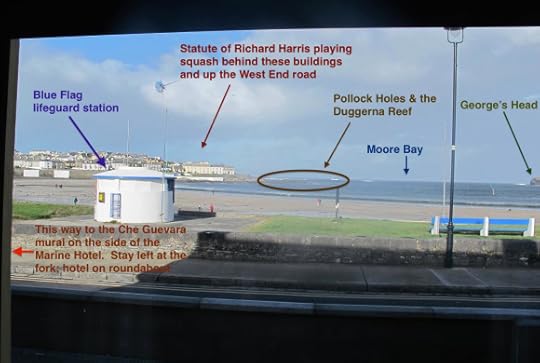
One of the features in the picture is George’s Head, the 100-foot cliff rising up from the bay on the right. It was off George’s Head that John Francis O’Reilly claimed to have ditched the wireless set provided by his German handlers of the Sicherheitsdienst (a/k/a/ “SD”) before turning himself in to the gardaí on the night of 16 December 1943. O’Reilly parachuted (out of a Heinkel He 111 or a Junkers JU-88 bomber) into Ireland a short distance from his parent’s home in Kilkee around 2 am and presented himself to the authorities later that evening after he learned the authorities were making inquiries. His radio transmitter and £143 of the £300 the SD handed him were recovered in the yard of his parent’s house. (See Terence O’Reilly’s book Hitler’s Irishmen and Anthony Kinsella’s article John Francis O’Reilly: The “Flighty Boy”).
Prior to his insertion as a German spy, O’Reilly read bulletins, poetry and other content on the Nazi’s Irland-Redacktion radio service aimed at spreading pro-German and anti-British propaganda to Irish audiences. Given his quick arrest and subsequent military prison sentence, O’Reilly did not feed the Germans information on US and British army and navy activity in Northern Ireland as originally instructed. As for the Richard Harris statute, Harris won the Tivoli Cup for Racquets in Kilkee four years in a row (1948-51).
Another has a personal connection to the view:
I’ve tried in vain to find the location, but haven’t been successful. The frustrating bit is the Royal National Lifeboat Institution (RNLI) lifeguard station in the picture – I thought that would help.
As an aside, I live in NYC and I am married to a Londoner. A few months before I met my (now) wife, her mother passed away. That I didn’t get the chance to meet my wife’s mother is my great loss – by every account she was an amazing and loving person and inspired all who knew her. She was also a supporter of good works, including the RNLI. And as a tribute to this amazing woman, I make a donation to the RNLI in her memory every year on the anniversary of her death.
This Irish Dishhead is very familiar with the area:
Total time to recognise this location: 0.05 seconds. But that’s hardly surprising as I’m from County Limerick, Ireland and most people from Limerick would be able to recognise Kilkee in less than a second. Kilkee, for most Limerick folk, is like a second home. During the summer months, Kilkee becomes Little Limerick for there is scarcely a family from Limerick that doesn’t have a relative who doesn’t own or rent a mobile home (caravan or trailer) or holiday home in Kilkee where they spend the majority of their summer holidays.
Personally, I’ve been going to Kilkee since before I can remember. When I was a kid, my parents used to rent a holiday home on the West End (the exact area isn’t actually captured n the photo but the white walls on the beech in the photo is an area where people play a hybrid of tennis/squash and our holiday home was just off the Dunlicky Road just behind that. It’s common for most Limerick people to leave work on a Friday evening and wish everyone well and tell them that you’ll see them on Monday, take the 70 minute trip down to Kilkee, get a bite to eat and head of to The Greyhound Bar or Fitzpatricks Pub or Scotts Bar (or any other Kilkee pub) and wind up having a drink with half of the people they’ve just wished a good weekend to at work.
The Dunlicky Road is very well known in Kilkee and is one of the famous walking routes in the area. The walk takes you up the Dunlicky Road over towards Intrinsic Bay (not too far away from the Diving Boards) and finally over to the Pollack Holes. It’s considered one of the best natural cures for a hangover. The Pollack Holes are natural holes that have formed in the rocks that are covered by the Atlantic during high and for six months of the year, are a breeding ground for Atlantic Pollack, but during the summer months, when the tide is out, they are one of the most populated swimming spots in Kilkee. But they’re bloody freezing at the best of times! If anyone from the Dish ever decides to visit the area, I have one recommendation: bring a wetsuit! I Googled the Pollack Holes just to see what I’d get back and came across this photo of a brave man who evidently had no fear of the cold … Christ only knows how he survived.
Springsteen played a gig in Limerick last year in Thomond Park (home to the Munster Rugby Team – “G’Wan Munster!”). During his stay in Ireland, The Boss took a trip down to
Kilkee and stopped in Scotts Bar on the Main Street (properly known as O’Curry Street) in Kilkee and the photo went viral on Facebook and twitter for all Limerick people who were raging that they missed the opportunity to get locked (drunk) with The Boss in one of Kilkee’s better watering holes (another tip for anyone planning on visiting Kilkee – avoid Miles Creeks pub – kind of a rough crowd.)
The window I found is different from the one in Google Maps, but that could be as a result of damage caused by a storm on February 12th of this year (subsequently nicknamed “Wild Wednesday”) that battered Kilkee and other locations on Ireland West Coast including Limerick City. The main bandstand in Kilkee was practically destroyed and quite a bit of damage was done to the promenade on Kilkee beach, but the local town council did a fantastic job of cleaning the area up and repairing the damage in time for the annual summer pilgrimage of Limerick residents to the area. I’m therefore assuming that the new looking wall and window were recently installed.
Another reader has a look at the damage from the storm:
More on the town from one of several contestants who’s been there::
Kilkee is a Victorian seaside resort in Co.Clare in the west of Ireland that was hugely popular with Irish families in the sixties and seventies before cheap flights to Spain and Portugal took them to more reliable sunshine. The small round white building is the lifeguards’ hut on the Strand Line promenade. The absence of a small flag from the roof indicates that they’re not in residence today, or not yet anyway. The shadows show the picture was taken in the morning. The hut is one of three round shelters that were originally built to cover fleeing beachgoers from the always imminent rain. The Strand Line seawall dates from Kilkee’s Victorian heyday, when Kilkee was popular with English visitors. Charlotte Bronte visited on her honeymoon in 1854. The seawall wraps around a magnificent horseshoe-shaped beach:
Sponsored Content: The Irish Tourist Board has asked me to point out that the Kilkee/Loop Head area has some truly stunning Atlantic seascapes, less well known than the Cliffs of Moher in the same county, but not as tourist-infested:
Kilkee is also a major centre for safe and spectacular scuba diving. And here’s Kilkee’s beach on a recent summer’s day, just as I remember it in the ’70s. Note the cloud shadow:
Speaking of shadows, Chini admits that even he suffers from routine bouts of contest terror:
After this much time and experience, you’d think it would go away; that terrifying feeling every time a new one pops up. That a sort of confidence would have developed. But no, it’s always the same. The mad desire to look around, that growing, gnawing sense of imminent failure, and the voice in the back of the head whispering “…you may never get this one.” Then, from nowhere, a sudden insight and a realization that there was nothing to worry about at all:
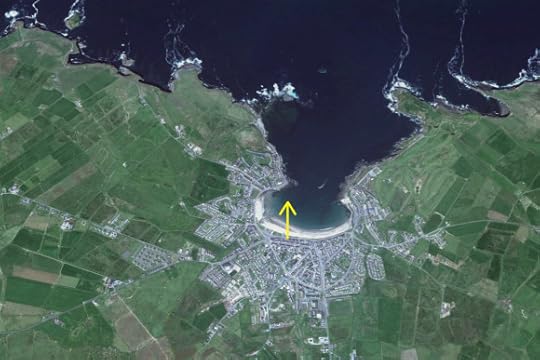
This week’s winner is a four-year-veteran who hails from our esteemed list of players who have guessed difficult contests in the past but never won:
This view shows us a day at the beach in Kilkee, a resort town in County Clare, Ireland. The double yellow lines next to the curb suggested we were somewhere in the British Isles. My gut told me this was probably a seaside town in Ireland, but I ignored my gut and went on an extended detour through the beaches of the United Kingdom. Bad call.
When that didn’t work, I went down a list of beaches in Ireland and found the beach in Kilkee. The view was taken from a one-story home on the Strand Line, a scenic street that runs parallel to the beach.
Kilkee has a number of claims to fame, one of which is that the actor Richard Harris used to summer there. The town honored him with a statue of him playing squash, which was unveiled by Harris’ family and Russell Crowe. Also, the sea wall in the background used to host (improbably) a 20-foot mural with the iconic image of Che Guevara, which would’ve been just out of view to the left had it not been painted over last year. Guevara spent a night in Kilkee and was recognized there by the artist Jim Fitzpatrick, who went on to create the famous image. The mural was painted over after it upset some Americans who saw it and apparently left town in protest. It’s fair to say that either the statue or the now-departed mural would’ve made memorable clues.
Congrats on a long-deserved victory. For everyone else, get ready for the next view Saturday!









The Case For Doing Nothing
It’s not often that I recommend watching an hour and a half of testimony from the British House of Commons Defense Committee. But I clicked on this link yesterday and gave up last evening to this debate about what to do about ISIS in Syria and Iraq. It’s simply a brilliantly calm and reasonable account of where we are over there, and why doing nothing and leaving the Middle East to its own devices is easily the sanest option available to the US and the UK.
These thoughts simply will not be aired in any Congressional Committee. But they are a blast of sanity and realism in an era of panic and atavism. They are a stark reminder of how vital it is that we have a president who at least understands the danger of intervention, even if he has caved to a very limited version of it. And also critical to understanding why the forces for intervention in the Clinton camp and most of the GOP – excluding Rand Paul, peace be upon him – are so terribly destructive for the United States and for the region as a whole.









Andrew Sullivan's Blog
- Andrew Sullivan's profile
- 153 followers



